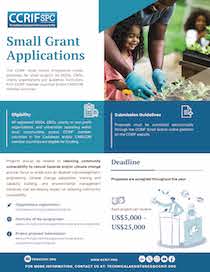Grand Cayman, Cayman Islands, August 13, 2015 – The 16 Caribbean member governments of CCRIF SPC (formerly the Caribbean Catastrophe Risk Insurance Facility) completed their catastrophe insurance portfolios for 2015/2016. All 16 Caribbean members renewed their hurricane policies; all 13 that had earthquake policies renewed those; and 12 obtained excess rainfall coverage – an increase of 4 over the 8 countries that purchased excess rainfall policies for the first time last year. The countries that purchased excess rainfall coverage for the first time in 2015/2016 were Antigua & Barbuda, The Bahamas, Jamaica and the Turks & Caicos Islands. CCRIF’s first Central American member, Nicaragua, purchased hurricane and earthquake policies and discussions are proceeding with other Central American countries for hurricane, earthquake and excess rainfall coverage.
The addition in 2014 of excess rainfall coverage to the CCRIF suite of insurance products provided early demonstration of its value: four payouts totalling US$3.4 million were paid to three member governments under their excess rainfall policies. One of these payouts was made to the Government of Anguilla after the passage of Hurricane Gonzalo, which did not trigger that country’s hurricane policy – which is based on wind speed and storm surge. The other three payments, including a second to Anguilla, were due to two trough systems that were not part of a tropical cyclone and which caused considerable damage to the affected countries. Barbados and St. Kitts & Nevis were the other two recipients of payouts for excess rainfall coverage last year.
CCRIF recognises the increasing economic and financial pressures faced by member governments and continues to seek to minimise premium costs and offer preferable options for member countries. For the 2015/2016 policies, CCRIF offered a premium package that included a 50% discount for hurricane and earthquake policies and a 15% discount on excess rainfall policies. This rebate was a way of providing a benefit to member countries based on CCRIF’s positive financial performance. Also, for hurricane policies, the facility offered to lower the minimum attachment point (or deductible) to a return period of 10 years. This means that CCRIF would begin to pay for losses resulting from a storm that statistically occurs every 10 years and therefore would increase the likelihood that a country would receive a payout. Member countries also were provided with the option to lower their policy exhaustion point, which is the severity of the losses that trigger the maximum payment. A lower exhaustion point makes the maximum payout more likely and increases the value of any payout made on the policy. The rebates and lower attachment/exhaustion points were well received by member governments.
Although the US National Oceanic and Atmospheric Administration (NOAA) predicted a below-average number of storms during the Atlantic Hurricane Season which ends on November 30, this still means that there is a likelihood of 6-11 named storms, 3-6 hurricanes and 0-2 major hurricanes occurring in the Atlantic this year – any of which could have major impacts in the region. CCRIF policies provide a measure of surety for member countries and are an indication of the importance they place on proactive ex-ante disaster risk management and planning.
About CCRIF SPC: CCRIF SPC is a segregated portfolio (SP) company, owned, operated and registered in the Caribbean. It limits the financial impact of catastrophic hurricanes, earthquakes and excess rainfall events to Caribbean and – since 2015 – Central American governments by quickly providing short-term liquidity when a parametric insurance policy is triggered. It is the world’s first regional fund utilising parametric insurance, giving governments in the region the unique opportunity to purchase earthquake, hurricane and excess rainfall catastrophe coverage with lowest-possible pricing.
CCRIF was developed under the technical leadership of the World Bank and with a grant from the Government of Japan. It was capitalised through contributions to a multi-donor Trust Fund by the Government of Canada, the European Union, the World Bank, the governments of the UK and France, the Caribbean Development Bank and the governments of Ireland and Bermuda, as well as through membership fees paid by participating governments. The Central America SP is supported by a capital fund comprising contributions from the World Bank and the governments of the United States and Canada and through membership fees paid by participating governments. Since the inception of CCRIF in 2007, the facility has made 12 payouts totalling approximately US$35.6 million to 8 member governments. All payouts were transferred to the respective governments within two weeks after each event.
English





